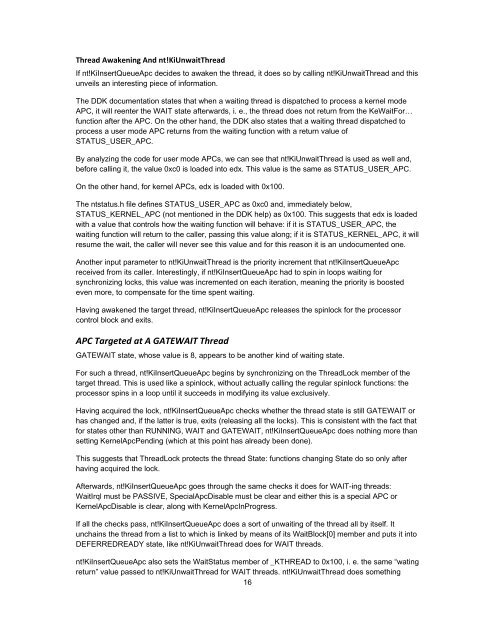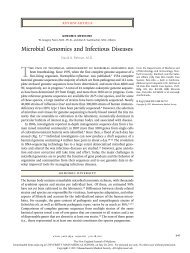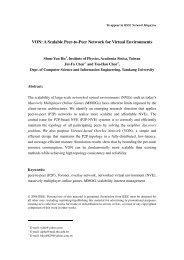366.7 KB - Evernote
366.7 KB - Evernote
366.7 KB - Evernote
Create successful ePaper yourself
Turn your PDF publications into a flip-book with our unique Google optimized e-Paper software.
Thread Awakening And nt!KiUnwaitThread<br />
If nt!KiInsertQueueApc decides to awaken the thread, it does so by calling nt!KiUnwaitThread and this<br />
unveils an interesting piece of information.<br />
The DDK documentation states that when a waiting thread is dispatched to process a kernel mode<br />
APC, it will reenter the WAIT state afterwards, i. e., the thread does not return from the KeWaitFor…<br />
function after the APC. On the other hand, the DDK also states that a waiting thread dispatched to<br />
process a user mode APC returns from the waiting function with a return value of<br />
STATUS_USER_APC.<br />
By analyzing the code for user mode APCs, we can see that nt!KiUnwaitThread is used as well and,<br />
before calling it, the value 0xc0 is loaded into edx. This value is the same as STATUS_USER_APC.<br />
On the other hand, for kernel APCs, edx is loaded with 0x100.<br />
The ntstatus.h file defines STATUS_USER_APC as 0xc0 and, immediately below,<br />
STATUS_KERNEL_APC (not mentioned in the DDK help) as 0x100. This suggests that edx is loaded<br />
with a value that controls how the waiting function will behave: if it is STATUS_USER_APC, the<br />
waiting function will return to the caller, passing this value along; if it is STATUS_KERNEL_APC, it will<br />
resume the wait, the caller will never see this value and for this reason it is an undocumented one.<br />
Another input parameter to nt!KiUnwaitThread is the priority increment that nt!KiInsertQueueApc<br />
received from its caller. Interestingly, if nt!KiInsertQueueApc had to spin in loops waiting for<br />
synchronizing locks, this value was incremented on each iteration, meaning the priority is boosted<br />
even more, to compensate for the time spent waiting.<br />
Having awakened the target thread, nt!KiInsertQueueApc releases the spinlock for the processor<br />
control block and exits.<br />
APC Targeted at A GATEWAIT Thread<br />
GATEWAIT state, whose value is 8, appears to be another kind of waiting state.<br />
For such a thread, nt!KiInsertQueueApc begins by synchronizing on the ThreadLock member of the<br />
target thread. This is used like a spinlock, without actually calling the regular spinlock functions: the<br />
processor spins in a loop until it succeeds in modifying its value exclusively.<br />
Having acquired the lock, nt!KiInsertQueueApc checks whether the thread state is still GATEWAIT or<br />
has changed and, if the latter is true, exits (releasing all the locks). This is consistent with the fact that<br />
for states other than RUNNING, WAIT and GATEWAIT, nt!KiInsertQueueApc does nothing more than<br />
setting KernelApcPending (which at this point has already been done).<br />
This suggests that ThreadLock protects the thread State: functions changing State do so only after<br />
having acquired the lock.<br />
Afterwards, nt!KiInsertQueueApc goes through the same checks it does for WAIT-ing threads:<br />
WaitIrql must be PASSIVE, SpecialApcDisable must be clear and either this is a special APC or<br />
KernelApcDisable is clear, along with KernelApcInProgress.<br />
If all the checks pass, nt!KiInsertQueueApc does a sort of unwaiting of the thread all by itself. It<br />
unchains the thread from a list to which is linked by means of its WaitBlock[0] member and puts it into<br />
DEFERREDREADY state, like nt!KiUnwaitThread does for WAIT threads.<br />
nt!KiInsertQueueApc also sets the WaitStatus member of _KTHREAD to 0x100, i. e. the same “wating<br />
return” value passed to nt!KiUnwaitThread for WAIT threads. nt!KiUnwaitThread does something<br />
16
















